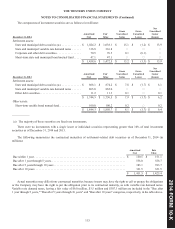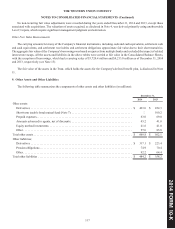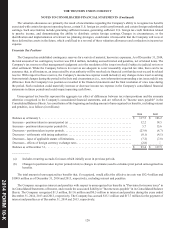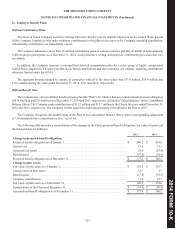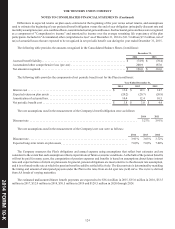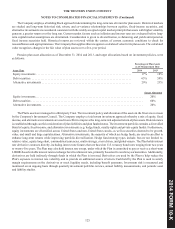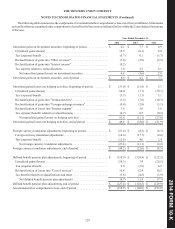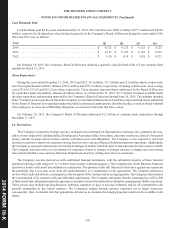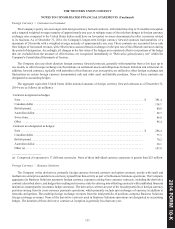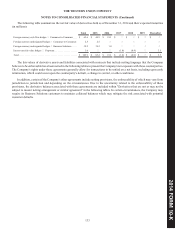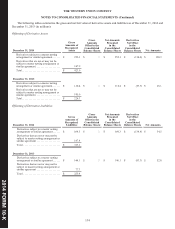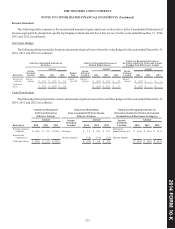Western Union 2014 Annual Report Download - page 263
Download and view the complete annual report
Please find page 263 of the 2014 Western Union annual report below. You can navigate through the pages in the report by either clicking on the pages listed below, or by using the keyword search tool below to find specific information within the annual report.
2014 FORM 10-K
THE WESTERN UNION COMPANY
NOTES TO CONSOLIDATED FINANCIAL STATEMENTS (Continued)
125
The Company employs a building block approach in determining the long-term rate of return for plan assets. Historical markets
are studied and long-term historical risk, return, and co-variance relationships between equities, fixed-income securities, and
alternative investments are considered consistent with the widely accepted capital market principle that assets with higher volatility
generate a greater return over the long run. Current market factors such as inflation and interest rates are evaluated before long-
term capital market assumptions are determined. Consideration is given to diversification, re-balancing and yields anticipated on
fixed income securities held. Historical returns are reviewed within the context of current economic conditions to check for
reasonableness and appropriateness. The Company then applies this rate against a calculated value for its plan assets. The calculated
value recognizes changes in the fair value of plan assets over a five-year period.
Pension plan asset allocation as of December 31, 2014 and 2013, and target allocations based on investment policies, were
as follows:
Percentage of Plan Assets
as of Measurement Date
Asset Class 2014 2013
Equity investments . . . . . . . . . . . . . . . . . . . . . . . . . . . . . . . . . . . . . . . . . . . . . . . . . . . . . . . . . . . . . . . . . 17% 18%
Debt securities . . . . . . . . . . . . . . . . . . . . . . . . . . . . . . . . . . . . . . . . . . . . . . . . . . . . . . . . . . . . . . . . . . . . 63% 59%
Alternative investments . . . . . . . . . . . . . . . . . . . . . . . . . . . . . . . . . . . . . . . . . . . . . . . . . . . . . . . . . . . . . 20% 23%
Target Allocation
Equity investments. . . . . . . . . . . . . . . . . . . . . . . . . . . . . . . . . . . . . . . . . . . . . . . . . . . . . . . . . . . . . . . . . . . . . . . . . 20%
Debt securities . . . . . . . . . . . . . . . . . . . . . . . . . . . . . . . . . . . . . . . . . . . . . . . . . . . . . . . . . . . . . . . . . . . . . . . . . . . . 60%
Alternative investments . . . . . . . . . . . . . . . . . . . . . . . . . . . . . . . . . . . . . . . . . . . . . . . . . . . . . . . . . . . . . . . . . . . . . 20%
The Plan's assets are managed in a third-party Trust. The investment policy and allocation of the assets in the Trust are overseen
by the Company's Investment Council. The Company employs a total return investment approach whereby a mix of equity, fixed
income, and alternative investments are used in an effort to improve the long-term risk adjusted return of plan assets. Risk tolerance
is established through careful consideration of plan liabilities and plan funded status. The investment portfolio contains a diversified
blend of equity, fixed-income, and alternative investments (e.g. hedge funds, royalty rights and private equity funds). Furthermore,
equity investments are diversified across United States and non-United States stocks, as well as securities deemed to be growth,
value, and small and large capitalizations. Alternative investments, the majority of which are hedge funds, are used in an effort to
enhance long-term returns while improving portfolio diversification. Hedge fund strategy types include, but are not limited to:
relative value, equity long-short, commodities/currencies, multi-strategy, event driven, and global-macro. The Plan holds interest
rate derivative contracts directly, including interest rate futures that are based on U.S. treasury bond rates ranging from two years
to twenty-five years. The Plan may also hold interest rate swaps, under which the Plan is committed to pay or receive a short-term
LIBOR-based variable interest rate in exchange for a fixed interest rate, primarily based on five and ten-year maturities. Additionally,
derivatives are held indirectly through funds in which the Plan is invested. Derivatives are used by the Plan to help reduce the
Plan's exposure to interest rate volatility and to provide an additional source of return. Cash held by the Plan is used to satisfy
margin requirements on the derivatives or meet liquidity needs, including benefit payments. Investment risk is measured and
monitored on an ongoing basis through quarterly investment portfolio reviews, annual liability measurements, and periodic asset
and liability studies.


